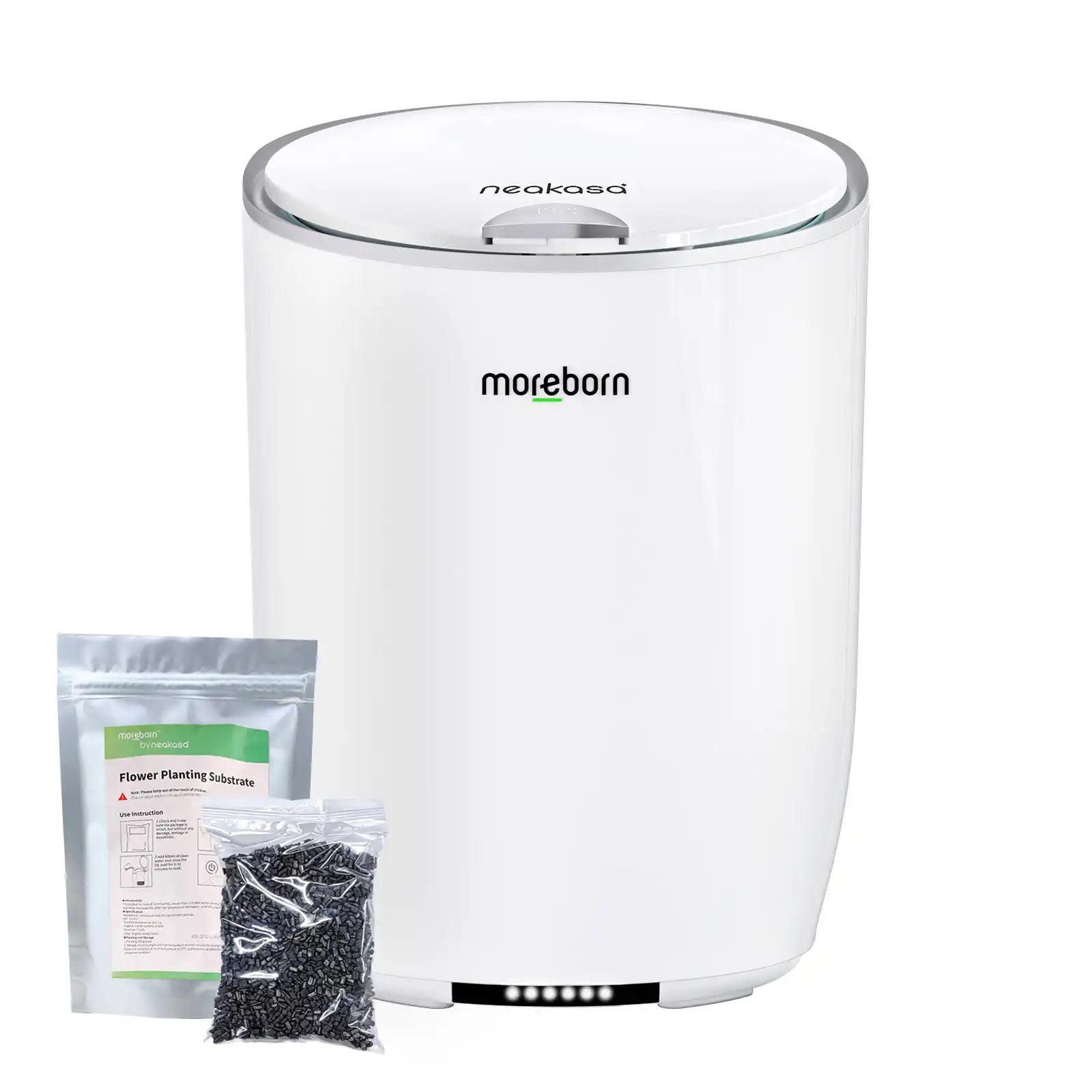




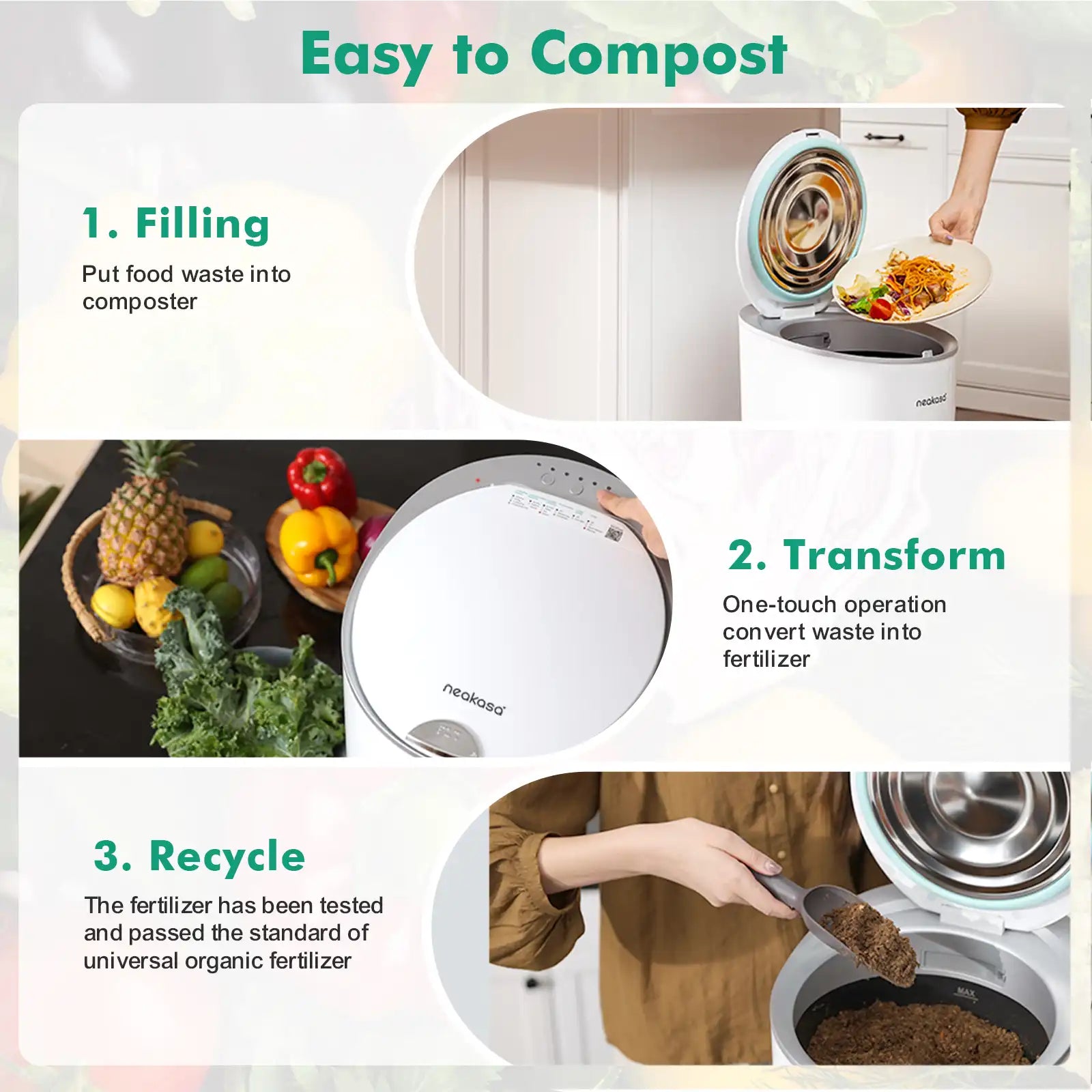


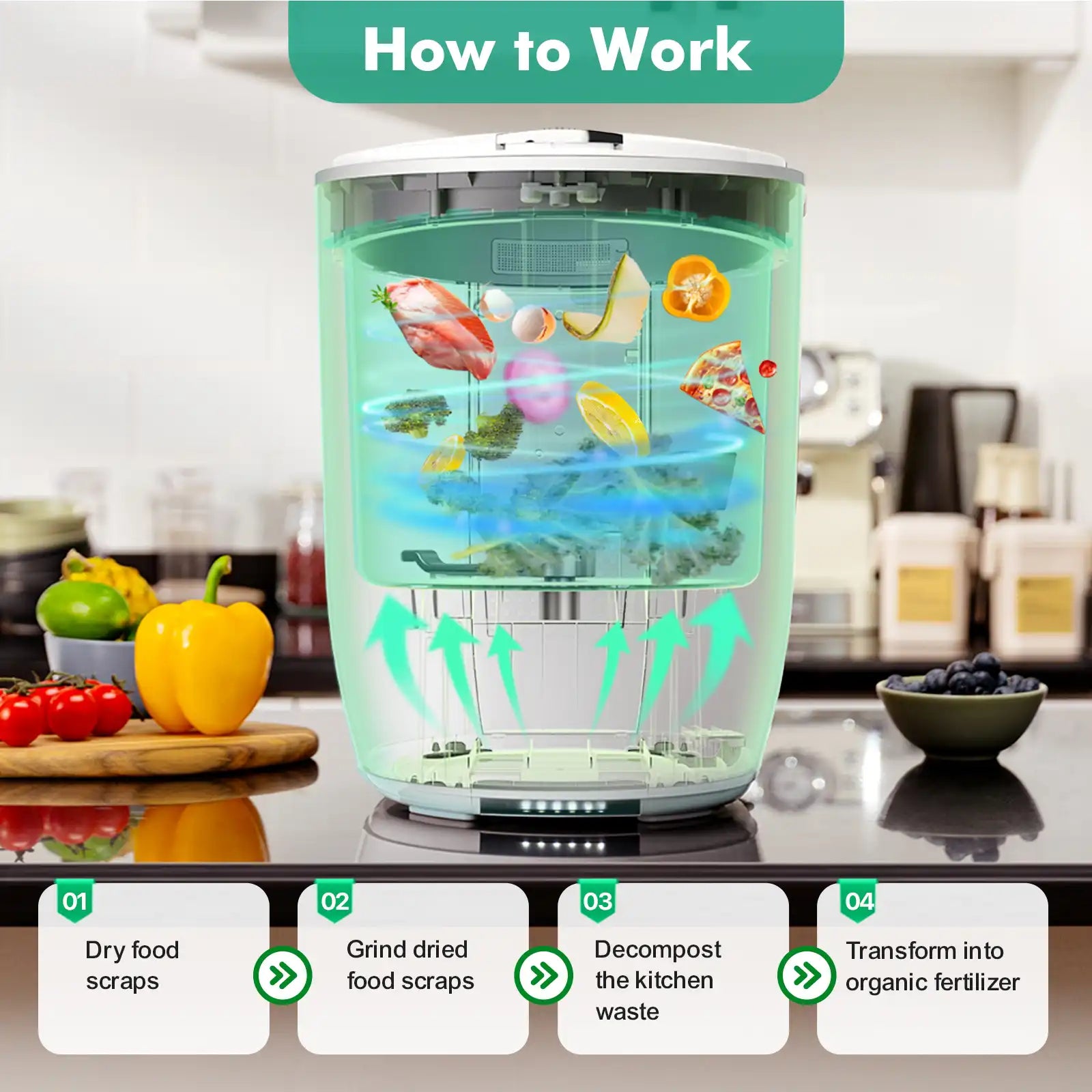




Make composting easy and convenient:


Note: Please note that we are unable to deliver to PO Box Addresses.

Feed your garden, not the landfill. Transform your kitchen waste into rich, nourishing fertilizer with the Neakasa composting bin, reducing waste and contributing to a greener planet.

1. Set up the composter with microbes
Power on the composter, add the microbial packet and spread it evenly. Then, add 800ml of water. Run the machine for 20 hours to activate the microbes before beginning use.
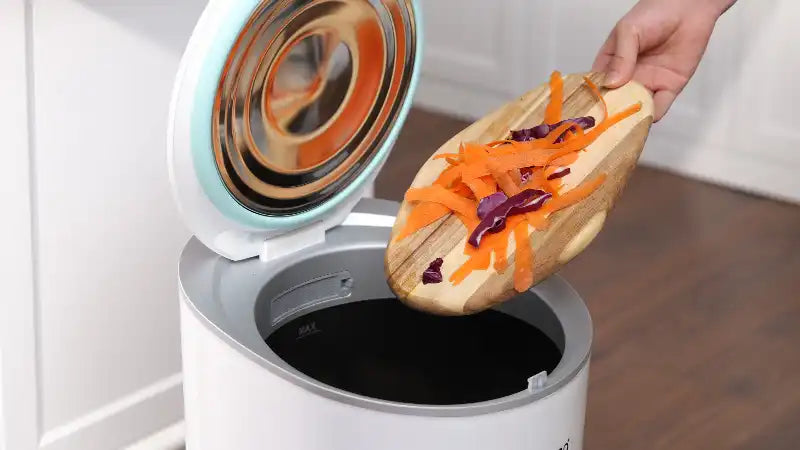
2. Efficient Composting Process
The composter begins by heating and grinding food scraps. Built-in sensors maintain optimal humidity and temperature, fostering microbial growth for efficient composting.

3. Transform organic waste into fertilizer
48 hours after adding kitchen waste, it will transform into high-quality organic fertilizer. Spread the nutrient-rich fertilizer on your garden or indoor plants.

With our specially formulated microbes, your kitchen waste will be converted into a stable, harmless organic fertilizer in just 48 hours, rather than merely drying out and grinding.
Experience a remarkable 93% reduction in volume and an 88% decrease in weight. In addition, thanks to the spacious 12L capacity, emptying is a rare task!

Neakasa kitchen composter features a large capacity of 12L, compared to the 3-4L capacity of most kitchen compost bins on the market.
You won't need to dispose of trash for over 30 days, eliminating concerns about overflowing garbage and the need to frequently remove compost. It saves you time and effort, making your home life more convenient.

Our dual deodorization system, featuring a PVC filter integrated with high-absorption activated carbon, ensures powerful odor control.
Moreover, the silicone sealing strip on the top cover prevents any odor leaks.
Each refill lasts 6-12 months (depending on use), keeping your kitchen odor-free.

Neakasa microorganisms can decompose most of the food waste, but a few items, like hard bones, should not be included.
Compost is a nutrient-rich source for plant growth. You can spread it directly onto the soil to improve its quality, enabling your lawn and yard plants to thrive.
If you're a gardening enthusiast, compost is the perfect companion for your plants. You can mix it with soil in a 1:10 ratio, creating an ideal environment for your plants to flourish.

Neakasa compost machine is a drying, grinding and composting 3-in-1 composting solution that comes fully equipped. Everything you need to kickstart your composting journey!

▶ Electric Kitchen Composter x 1
▶ Fertilizer Shovel x 1
▶ Cleaning Brush x 1
▶ Neakasa Microbial Pack x 1
▶ Activated Carbon Pack x 1
▶ User Manual x 1
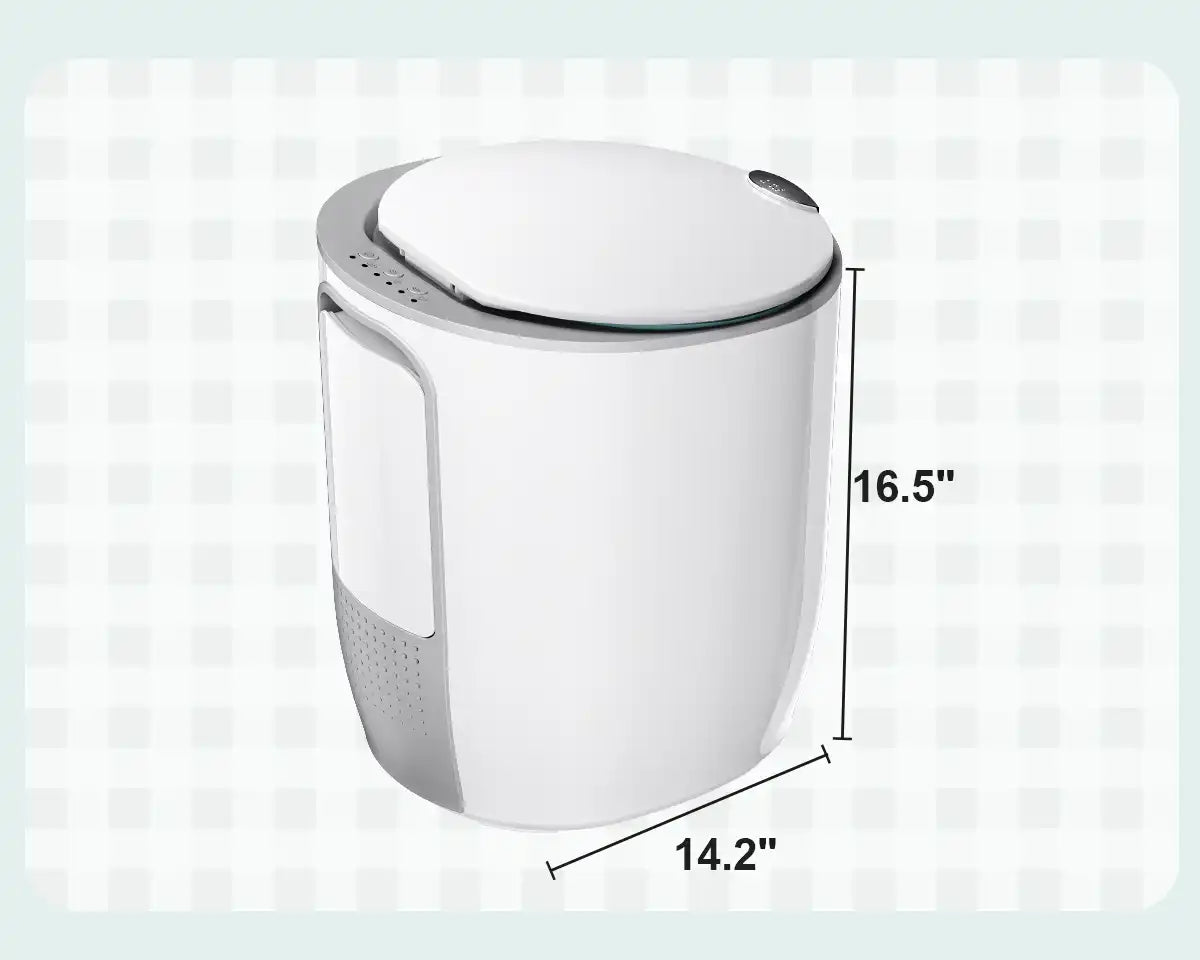

11.8" W x 14.2" D x 16.5” H
8.5 kg (18.74 lbs)
12 litres
120V
≤ 45dB
Within 4 hours decomposition / 48+ hours compost.
- Open the package and evenly distribute the entire pack of microorganisms inside the product.
- Add 800ml of clean water, then close the lid. Allow 5-10 minutes for the microorganisms to soak.
- Power on the Moreborn and let it run for over 20 hours to fully activate the microorganisms. (The initial sound from churning is normal and will subside after a few minutes.)
- After activation, open the lid, add the food waste, and allow the machine to process and compost it.
Note: Try to reduce the moisture in soup-like food waste and minimize salt content in the meals before composting.
The Neakasa composter has a large capacity of 12L. It can process up to 9-10L of food waste at a time (up to the indicator line inside the drying barrel).
The optimal amount for a single processing is less than 2L (processing time may vary depending on the weight and moisture content of the food waste).
※ When inputting small volume and high moisture content food, a maximum of 2 kg can be input.
1. Activated Carbon Packs
Our kit includes one pack of activated carbon. For standard use of 2-3 times a week, the filter should be replaced every 4-6 months, depending on actual usage.
2. Microbial Packets
Generally, frequent supplementation is not necessary. Microorganisms use nutrients from food waste to synthesize and reproduce. You only need to keep thetotal amount of compost inside the product above the minimum fill line at all times.However, for optimal performance, we recommend adding a microbial supplement pack once a month
(available at neakasa.com). Professional users can culture their own microorganisms while non-professionals or beginners can purchase our supplement pack directly.
The composter can process almost all types of kitchen waste categorized as food waste, including fruits, vegetables, meat, fish, chicken, cooked egg, grains, nuts, legumes, coffee grounds, cheese, bread cookies, noodles, and steams roots rinds.
However, certain parts of food waste, cannot be processed and should be disposed of as regular trash, such as: bones, shells, tough husks, fruit pits, cooking oil, disposable tableware, glass metal, medicine, cigarette, paper tape, plastic rubber.
※ The Neakasa composter can process small chicken bones and fish bones, but processing hard substances may damage the coating of the drying barrel or reduce the product's lifespan.
The Neakasa composter consumes electricity similar to a refrigerator. If 500g of kitchen waste is processed twice daily, it consumes 1.76 kWh, averaging 0.073 kWh per hour.
The first stage of processing, which involves drying and weight reduction, takes 2-4 hours.
The second stage, which involves fermentation into quasi-organic fertilizer, takes 48-72 hours.
※ Processing time may vary depending on the type of food, moisture content, and usage environment.
During normal operation, the noise level of the product is less than or equal to 45 decibels, similar to the normal operating noise of a refrigerator.
The average weight reduction rate is about 80% to 90%, with a maximum reduction of up to 95%.
※ The reduction rate may vary depending on the type of food, moisture content, and product usage environment.
The Neakasa composter needs to be plugged in and on standby during use.
When there is food waste in the product, the power should be turned on.
In standby mode, the product's energy-saving composting mode activates, using air circulation to capture the smell of processing food and prevent decay over time.
After the first stage (2-4 hours) of processing, the food waste is dried and can be considered dry waste, which can be thrown away as regular trash.
After the second stage (48-72 hours) of fermentation, the result is quasi-organic fertilizer, which can be used as planting fertilizer like regular organic fertilizer. It can also be mixed with soil, coconut shell, or other brown materials in a 1:10 ratio to become nutrient soil for planting.
If there is excess nutrient soil, it can be spread on outdoor public lawns or shrubbery, or shared with neighbors.
For standard use of 2-3 times a week, the filter should be replaced every 4-6 months. However, the filter's lifespan may vary depending on the type and quantity of food processed. The used filter can be opened, and the internal carbon bag can be replaced and disposed of in the food waste processor's drying barrel.
※ Replace the filter if there is a noticeable odor of rotting food, even if the filter is functioning correctly for slightly cooked food smells.
Food can be added at any time during the product's operation. The new food will be incorporated into the processing, and the operation time will be recalculated based on the changes in temperature and humidity.
The product does not emit an odor when the filter is functioning correctly. If there is a compost smell, it is recommended to purchase a new filter. Alternatively, add a scoop of used coffee grounds or some bread into the machine, then press stop and avoid adding food waste for 10 hours. Wait for the smell to disappear or diminish before adding food waste again.
If the odor persists, check the carbon box by opening the machine's back filter and inspecting for excessive moisture. In some humid environments, the filter may lose its filtering capacity due to high humidity.
The Neakasa composter has a unique temperature and humidity control system with specific limitations, so only the specially matched starter should be used to ensure effective composting and odor control. Using other brands' starters may result in extended composting times or even composting failure, or produce a bad smell.
- For trips less than a week:
There's no need to power off the machine; it will automatically enter eco-energy-saving mode, consuming only 0.3 kWh per day.
- For trips longer than a week:
Do not add any more kitchen waste 48 hours before departure to allow the existing waste to ferment and decompose properly. Power off the machine when you leave.
Upon returning, check if there is any dry clumping or mold growth inside.
- If there are no clumps or mold, power on and continue using the machine.
- If there are clumps, break them up with a hard object, add a small amount of water to cover the clumps, and then power on the machine.
- If there is mold, add some dry leaves, sawdust, paper, coffee grounds, or other brown materials, and use the machine for a while after powering on.
ECO mode involves adjusting temperature and humidity after the food waste is reduced in weight, and the output material does not have a bad smell but has not yet fermented into organic fertilizer.
Composting mode indicates that the food waste is in the composting process, and users should wait for it to complete.
This product is rated 4.8 of 5.0 stars.
It has received 4 reviews.